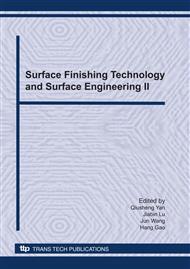p.1
p.7
p.13
p.18
p.24
p.30
p.36
p.41
p.46
Effect of Abrasive on the Machining Performance the EMR-Effect-Based Tiny-Grinding Wheel
Abstract:
Based on the electro-magneto-rheological (EMR) effect, the Fe3O4-based EMR fluid dispersed with micron-sized finishing abrasives is used as a polishing fluid to form a dynamical tiny-grinding wheel under an electro-magnetically coupled field. Using this EMR-effect-based tiny-grinding wheel, experiments were conducted to investigate the effect of the grain size, content and material of abrasive on material removal effect of normal glass. Results indicate that the abrasive can change the chain-like structure of the EMR-effect-based tiny-grinding wheel and influence the material removal ability of the tiny-grinding wheel remarkably. The material removal amount increases with the increase of the content of diamond abrasive in the EMR fluid, and grows slowly when the proportion of diamond abrasive exceeds to 6%. While the grain size of abrasive increases, the material removal amount increases at the beginning and decreases afterwards. The effect of abrasive on material removal depends on the hardness of abrasive, the greater the abrasive hardness, the higher the material removal efficiency. The machined area has a close relationship with both the density and grain size of abrasive.
Info:
Periodical:
Pages:
24-29
Citation:
Online since:
October 2010
Authors:
Price:
Сopyright:
© 2010 Trans Tech Publications Ltd. All Rights Reserved
Share:
Citation:


